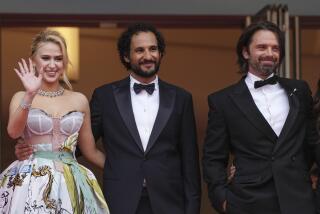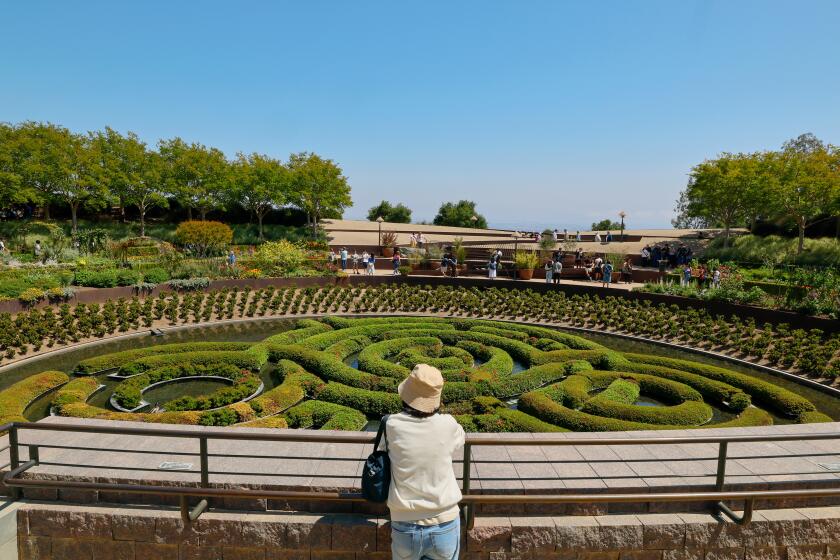British Art World Upset by Getty Bid
Once again the British art world is lamenting the probable loss of a national artistic treasure to those rich Yankees from Los Angeles. This time it’s a landscape by 17th century French painter Nicolas Poussin, sold by Britain’s richest, most eligible bachelor to the J. Paul Getty Museum for a whopping $26 million.
The painting is called “Temps Calme” (Landscape With Calm), but there was nothing sedate about the reaction of British art experts Friday.
“I’d be surprised if there isn’t some effort to keep the painting here. For some people, the very name ‘Getty’ is a red rag to a bull,” said Roger Hollest, who heads the auction house Phillips of Bond Street.
Henry Dent-Brocklehurst, described by British newspapers as a close friend of actress Elizabeth Hurley, will use the money to maintain his 1,200-acre estate at Sudeley Castle, a historic landmark in the tumult of 17th century English civil war between British royalists and Oliver Cromwell.
“I thought when I read the headline in the Times [of London] this morning that perhaps Cromwell ought to have done more to demolish the castle,” said art expert Clovis Whitfield, who in 1975 first authenticated the painting as a genuine Poussin.
British specialists blanched at the painting’s price tag. In 1977, it was withdrawn from a sale at which it had been offered at 10,000 pounds, Whitfield said. The Getty’s bid of 16 million pounds, says Whitfield, “represents one of the most spectacular increases in the art world.”
Although the opposition to the Getty bid is manifest, there seems little optimism among experts that the painting can remain in Britain.
By the standards of most European countries, British art export laws are extremely liberal. The government will intervene only if the work of art is judged to be closely connected with national history; if it is of outstanding aesthetic importance; or if it has outstanding significance to the study of some branch of art, learning or history.
An assessor, probably from the National Gallery, will study the painting and weigh the Getty’s export request against the three points. Almost certainly he will invoke them and refer the request to a blue-ribbon review committee that meets about once a month under the government’s Department of National Heritage.
As committees go, the export panel, headed by John Guinness of the brewery family, is open to persuasion. It judges 30 to 40 cases each year and refuses the export of around 10 of them.
“In the case of the Poussin, the export application will be opposed and then we’ll have to see what develops. I have heard of no rescue campaign so far,” said Humphrey Wine, the Poussin curator at the National Gallery.
Britain is especially furbished with Poussins. There are 13 at the Gallery and perhaps two dozen others scattered among other British museums and private collectors, said Wine. “Still, there is always some sadness when a good picture leaves.”
If there seems a groundswell for keeping a particular work, the export committee can effectively freeze everything while British collectors scramble for the money to match the bid.
To “save” a work from going abroad, museums and galleries sometime band together to make a bid, and sometimes Britain’s National Lottery will contribute as much as 75% of the cost.
In 1989, the Victoria & Albert Museum and the National Gallery of Scotland combined to halt the Getty Museum’s export of Antonio Canova’s neoclassical “Three Graces.” The sculpture is now on display in Edinburgh.
In 1988, the National Gallery and the National Museum and Gallery of Wales combined to stop export to the Getty of Poussin’s “Finding of Moses.”
Last year, British curators bought a Getty-sought painting by Il Guercino, but failed to stop export to the Getty of a $22-mil lion painting by Italian Renaissance artist Fra Bartolommeo, “The Rest on the Flight Into Egypt With Saint John the Baptist.”
According to Jeremy Warren, assistant director of the government’s Museums and Galleries Commission, and other experts, the free-spending Getty is the single largest purchaser of what is called “heritage items” that require export permission. “In the last four years, they have exported 50 million pounds worth of pieces that our institutions could not match, including works by Rembrandt, Turner and Giulio Romano,” said Warren.
More to Read
The biggest entertainment stories
Get our big stories about Hollywood, film, television, music, arts, culture and more right in your inbox as soon as they publish.
You may occasionally receive promotional content from the Los Angeles Times.






